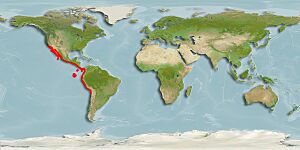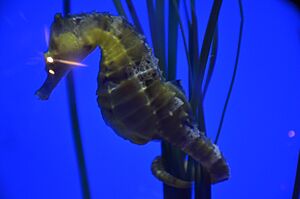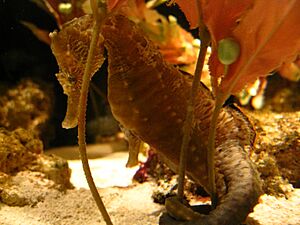Pacific seahorse facts for kids
Quick facts for kids Pacific seahorse |
|
|---|---|
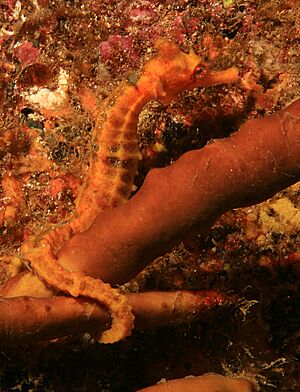 |
|
| Conservation status | |
| Scientific classification | |
| Synonyms | |
|
The Pacific seahorse, also called the giant seahorse, is a type of fish found in the Syngnathidae family. Its scientific name is Hippocampus ingens. The name Hippocampus comes from Greek words: hippos means "horse" and campus means "sea monster." This seahorse is the only one of its kind found in the eastern Pacific Ocean.
Contents
Meet the Pacific Seahorse
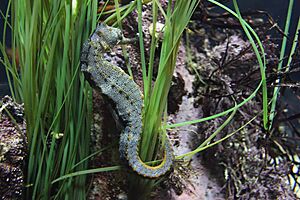
Pacific seahorses are among the biggest seahorses. Adults usually grow to be about 12 to 19 centimetres (4.7 to 7.5 in) tall. Some can even reach up to 30 centimetres (12 in)! When they are born, baby seahorses are tiny, only about 9 mm long. Their large size is important for their protection. Rules often protect seahorses that are at least 10 cm. So, knowing their exact size helps make sure they are safe.
These seahorses come in many colors. You might see them in green, brown, maroon, grey, or yellow. Male seahorses have a special ridge called a keel, which helps tell them apart from females.
Pacific seahorses have many traits common to all seahorses. They have a tail that can grab onto things, like plants. Their skin is smooth, not scaly. They don't have teeth and can move each eye on its own. They also have a unique digestive system without a clear stomach. The Pacific seahorse is one of six species that are very threatened by being caught and traded too much. This is according to a group called CITES, which works to protect wildlife.
Where Pacific Seahorses Live
Pacific seahorses live in the Pacific Ocean. Their home stretches from Baja California in Mexico all the way down to Chile. Sometimes, a group of them can be found near San Diego. The only known group living around an ocean island is near the Galapagos Islands. Some also live in Northern Peru.
These seahorses are active at night. They live in many underwater places, sometimes as deep as 60 metres (200 ft). You can find them in mangroves, seagrass meadows, rocky reefs, coral reefs, and among sponges. They also like to hide in sea kelp and eelgrass. They are good at blending in with gorgonians and black corals.
South America has many water habitats. Because of this, it's a place where wildlife can be harmed. Many species, like the Pacific seahorse, are affected. Peru, for example, is known for trading many Pacific seahorses. This trade often happens in ways that are not allowed.
In 2015, Pacific seahorses were seen for the first time near Guadalupe Island, Mexico. This is a northern island, different from their usual homes. Scientists think they might be moving to new places because their populations are vulnerable. Other seahorse species have also been moving to new areas.
Before 2004, people didn't realize how much Latin American countries were involved in seahorse trade. That's when CITES started collecting data on seahorses. Now we know that countries like Peru and Mexico are big players in this trade. Even though the Pacific seahorse lives in the Eastern Pacific, its trade has spread far beyond this area.
Pacific Seahorse Behavior
Reproduction and Life Cycle
Female Pacific seahorses in aquariums have been seen having small groups of babies when they are just three months old. Sexually mature females often get a dark spot near their anal fin. Males become ready to reproduce when they are about 5.4 centimetres (2.1 in) tall. In captivity, some males have had successful pregnancies as early as six months old.
Like all seahorses, the female puts her eggs into a special pouch on the male. The male then fertilizes the eggs inside his pouch. As the babies grow, the fluid in the pouch changes. This helps the baby seahorses get used to the saltiness of the ocean water. Studies suggest that male Pacific seahorses can carry up to 2000 eggs at once. They might even have several groups of babies in one breeding season. After about fourteen days, the male goes into labor. He has to push the young out of his pouch one by one, which can sometimes take hours!
Development
Once born, baby seahorses are completely independent. They don't need their parents anymore. Scientists think that young seahorses spend their first few months in the open ocean. This idea comes from how their fins look and how they don't try to grab onto things like adult seahorses. However, this hasn't been directly seen in the wild.
Even though they don't have a stomach, young Pacific seahorses have a strong digestive system. Their intestine does most of the work. It has a large area to help with digestion. They also have enough enzymes to break down their food, including the fats they need a lot of.
Diet
Pacific seahorses eat small creatures that live on the ocean floor. This includes tiny shrimp called mysids, other small crustaceans, and plankton. Like most seahorses, they are "ambush predators." This means they hide and wait for their prey to swim by. Then, they quickly suck their prey in and swallow it whole, since they don't have teeth.
Evolutionary Journey
Pacific seahorses have low genetic diversity. This means there isn't much variety in their genes, which makes them more vulnerable. Because of this, it's hard to figure out exactly where this species first came from. Scientists are studying their genes more closely to learn about their origins and how they are moving to new places.
We do know that the seahorse family tree leading to modern Pacific seahorses separated from slender seahorses a long time ago. This happened after the Isthmus of Panama formed, about 4 to 5 million years ago. Pacific seahorses and Fisher's seahorses then split from this group about 2.5 to 3 million years ago.
One study looked at the digestive system of the Pacific seahorse. It found that their intestine is similar to other seahorse species that also don't have a stomach. This suggests these species might have come from a common ancestor. More research is needed to confirm this idea.
Conservation Status
Threats to Pacific Seahorses
Pacific seahorses face many dangers, just like other seahorses. More than 20 million seahorses are sold each year. They are used in traditional medicine, sold to aquariums, or dried and sold as souvenirs. Mexico and Peru are big exporters of Pacific seahorses, selling over a dry ton every year. Seahorses are easily over-harvested because they don't have many babies at once. They also tend to mate with only one partner, their babies take a long time to develop, and they don't travel far.
Their homes are also being damaged by humans. Pollution and destruction of habitats threaten Pacific seahorses. They are also often caught by accident in large fishing nets, which is called "bycatch."
Traditional medicine is a major reason why Pacific seahorses are at risk. Their large size and smooth texture make them popular for this use. These seahorses are often ground into powder and used as home remedies for common illnesses.
Humans also catch and kill seahorses to make crafts and jewelry. Local people sometimes sell these items to tourists. You can even find seahorse products sold online.
Efforts to Protect Them
There are efforts to stop the over-harvesting of Pacific seahorses, but enforcing the rules can be hard. For example, in Mexico, Pacific seahorses are listed as a species needing special protection. Yet, Mexico is still a leading country in their trade. Many countries have tried to ban some of the activities that harm seahorses. In 2004, all seahorse species were added to Appendix II of CITES. This means their trade is controlled to prevent them from becoming extinct. As a result, countries like Peru, which were involved in the trade, made their own bans. However, illegal activities still continued.
Scientists are looking for new ways to fight the exploitation of Pacific seahorses and help their populations grow. One study tried to help baby seahorses by giving them special food. They found that feeding them different foods in their first few months greatly improved their survival.



